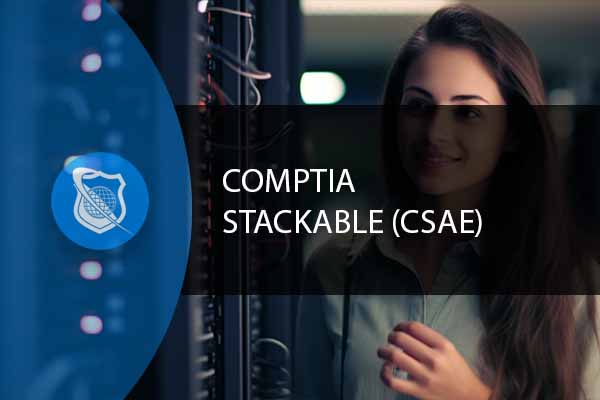CompTIA Security Analytics Expert (CSAE)
If you’re an IT professional with five or more years of experience, the CompTIA CSAE is a stackable certification designed just for you. The accompanying ITU Certification Path provides all the learning materials to help ace your exams in Security+, Cybersecurity Analyst (CySA+), and CASP+. So let’s get started on achieving this sought-after recognition!
Included In This Course



Closed Captions



Certificate of Completion
CompTIA CSAE Certification Training
The CompTIA CSAE is a stackable certification series by CompTIA. It is designed for IT professionals with 5 or more years of experience. The ITU Certification Path for the CompTIA CSAE certification consists of the learning materials to allow you to study for and pass the CompTIA Security+, CompTIA Cybersecurity Analyst (CySA+) and CompTIA CASP+ exams. It also provides access to self-paced IT online training from ITU, the worlds leading IT training and professional development provider. The CompTIA CSAE certification path is perfect for those who want to take their career to the next level and become a dominant leader and hone their cybersecurity mastery in the IT security field.
Secure an exceptional bargain on this training series; don’t miss out on this limited-time opportunity to save! View our Master CompTIA Training Series which includes the courses provided in this CompTIA certification training series.
Career Pathways and career information
Completing this career pathways and passing the three exams means you end of with three CompTIA certifications and are a designated a CompTIA Security Analytics Expert (CSAE).
The three courses contained in this path are:
- CompTIA Security+
- CompTIA Cybersecurity Analyst (CySA+)
- CompTIA Advanced Security Practitioner (CASP+)
CompTIA Stackable Certifications
The certifications are divided into experience levels, organized by their associated pathways:
- Specialist: IT professionals in the early stages of their career, with 0-2 years of experience (Early-career IT professionals)
- Professional: Experienced IT professionals with a minimum of two to five years in the field (Mid-level IT professionals)
- Expert: Experienced IT professionals with 5+ years of expertise
Upon passing the relevant exams provided by CompTIA, you will be rewarded with your very own CSAE certification badge.
What will the successful completion of the professional certifications do for me?
By obtaining the CompTIA Security Analytics Expert (CSAE) certification, you will have shown proficiency and deeper mastery in security analytics and be able to conceptualize, engineer and build cybersecurity solutions that meet regulations. With this technical knowledge comes the ability to research cyber security through data analytics and develop advanced security program that is highly sought after by many employers and will provide you with the competitive edge to propel your IT Career. With your technical skills, you will:
- Have a deep knowledge of security concepts and identify security risks
- Develop security incidentsPlan based on software systems
- Asses Cloud-based network security issues
- Map analytics to networks
- Security experience in networking
- VulnerabilitiesTest applications
To explore the potential of CompTIAs Stackable Certifications, please pay a visit to their official website. Pricing for these certifications will differ depending on the exam. To find out current pricing information, head over to CompTIAs Pricing page online.
Frequently Asked Questions About CompTIA Security Analytics Expert (CSAE)
What is the CompTIA Security Analytics Expert (CSAE) certification?
The CompTIA CSAE is a stackable certification designed for IT professionals with five or more years of experience. The certification includes materials to study for and pass the CompTIA Security+, CompTIA Cybersecurity Analyst (CySA+), and CompTIA CASP+ exams.
What are the benefits of obtaining the CSAE certification?
Obtaining the CSAE certification will demonstrate proficiency and deeper mastery in security analytics. You’ll be able to conceptualize, engineer, and build cybersecurity solutions that meet regulations. This certification is highly sought after by many employers and will provide a competitive edge in your IT career.
What does the course cover?
The course provides a comprehensive path to help you ace your exams in Security+, Cybersecurity Analyst (CySA+), and CASP+. After successful completion, you’ll have a deep knowledge of security concepts, be able to identify security risks, develop security incidents based on software systems, assess Cloud-based network security issues, map analytics to networks, and test applications for vulnerabilities.
Who are the training instructors for this course?
The course is taught by Chrys Thorsen, an education and technology expert who specializes in enterprise-level IT infrastructure consulting and certified training-of-trainers; John Abueg, a Senior Technical Instructor at Ft. Gordon in Augusta, Georgia; and Brian O’Hair, an IT Training Professor with over 25 years of experience in the IT industry.
What career pathways are available after completing the CSAE certification?
After completing the CSAE certification and passing the three exams, you’ll be designated a CompTIA Security Analytics Expert. The certification covers three experience levels: Specialist for IT professionals in the early stages of their career (0-2 years of experience), Professional for experienced IT professionals with a minimum of two to five years in the field, and Expert for experienced IT professionals with 5+ years of expertise.
Proudly DisplayYour Achievement
Upon completion of your training, you’ll receive a personalized certificate of completion to help validate to others your new skills.
CompTIA Security+ SY0-601 (2022) Course Content
Module 1 - Introduction to Security
- 1.1 Introduction to Security
Module 2 - Malware and Social Engineering Attacks
- 2.1 Malware and Social Engineering Attacks
Module 3 - Basic Cryptography
- 3.1 Basic Cryptography
Module 4 - Advanced Cryptography and PKI
- 4.1 Advanced Cryptography and PKI
Module 5 - Networking and Server Attacks
- 5.1 Networking and Server Attacks
Module 6 - Network Security Devices, Designs and Technology
- 6.1 Network Security Devices, Designs and Technology
Module 7 - Administering a Secure Network
- 7.1 Administering a Secure Network
Module 8 - Wireless Network Security
- 8.1 Wireless Network Security
Module 9 - Client and Application Security
- 9.1 Client and Application Security
Module 10 - Mobile and Embedded Device Security
- 10.1 Mobile and Embedded Device Security
Module 11 - Authentication and Account Management
- 11.1 Authentication and Account Management
Module 12 - Access Management
- 12.1 Access Management
Module 13 - Vulnerability Assessment and Data Security
- 13.1 Vulnerability Assessment and Data Security
Module 14 - Business Continuity
- 14.1 Business Continuity
Module 15 - Risk Mitigation
- 15.1 Risk Mitigation
Module 16 - Security Plus Summary and Review
- 16.1 - Security Plus Summary and Review
Module 17 - Hands-On Training
- 17.1 Hands-On Scanning Part 1
- 17.2 Hands-On Scanning Part 2
- 17.3 Hands-On Advanced Scanning
- 17.4 Hands-On MetaSploit
- 17.5 Hands-On BurpSuite
- 17.6 Hands-On Exploitation Tools Part 1
- 17.7 Hands-On Exploitation Tools Part 2
- 17.8 Hands-On Invisibility Tools
- 17.9 Hands-On Connect to Tor
CompTIA CySA+ (Cybersecurity Analyst+) CS0-002 Course Content
Module 1: Threat and Vulnerability Management
- Instructor Intro
- About the Exam
- Test Taking Tips and Techniques
- Explain the importance of threat data and intelligence
- Given a scenario, utilize threat intelligence to support organizational security
- Given a scenario, perform vulnerability management activities Pt 1
- Given a scenario, perform vulnerability management activities Pt 2
- Given a scenario, analyze the output from common vulnerability assessment tools
- Explain the threats and vulnerabilities associated with specialized technology
- Explain the threats and vulnerabilities associated with operating in the Cloud
- Given a scenario, implement controls to mitigate attacks and software vulnerabilities Pt 1
- Given a scenario, implement controls to mitigate attacks and software vulnerabilities Pt 2
Module 2: Software and Systems Security
- Given a scenario, apply security solutions for infrastructure management Pt 1
- Outline
- Given a scenario, apply security solutions for infrastructure management Pt 2
- Given a scenario, apply security solutions for infrastructure management Pt 3
- Flashcards
- Explain software assurance best practices
- Scatter
- Explain hardware assurance best practices
- Learn
- Speller
- Workbook
Module 3: Security Operations and Monitoring
- Given a scenario, analyze data as part of security monitoring activities Pt 1
- Given a scenario, analyze data as part of security monitoring activities Pt 2
- Given a scenario, analyze data as part of security monitoring activities Pt 3
- Given a scenario, implement configuration changes to existing controls to improve security Pt 1
- Given a scenario, implement configuration changes to existing controls to improve security Pt 2
- Explain the importance of proactive threat hunting
- Compare and contrast automation concepts and technologies
Module 4: Incident Response
- Explain the importance of the incident response process
- Given a scenario, apply the appropriate the incident response procedure
- Given an incident, analyze potential indicators of compromise
- Given a scenario, utilize basic digital forensic techniques
Module 5: Compliance and Assessment
- Understand the importance of data privacy and protection
- Given a scenario, apply security concepts in support of organizational risk mitigation Pt 1
- Given a scenario, apply security concepts in support of organizational risk mitigation Pt 2
- Explain the importance of frameworks, policies, procedures, and controls Pt 1
- Explain the importance of frameworks, policies, procedures, and controls Pt 2
Module 6: Afterword
- Recap
- Review Questions
- Before the Exam
CompTIA Advanced Security Practitioner (CASP) CAS-003 Course Content
Module 1 - Risk Management
- Module 1 Notes
- Intro CASP
- CASP Introduction
- Mod 1.1 Exploring Cloud Services Act
- Mod 1.1 Acquisition Merger Demerger
- Mod 1.1 Acquisition Merger Demerger Part2
- Mod 1.2 Compare and Contrast
- Mod 1.3 Given Scenario Execute Risk
- Mod 1.3 Given Scenario Execute Risk Part2
- Mod 1.3 Continuing Terminology IT Governance
- Mod 1.4 Analyze Security Solution Metrics and Attributes
- Mod 1.4 Analyze Risk
- Mod 1.4 Trend Analysis Act
Module 2 - Enterprise Security Architecture
- Module 2 Notes
- Mod 2 Enterprise Security Architecture
- Mod 2.1 Network Device Security Act
- Mod 2.1 Application and Protocol
- Mod 2.1 Advanced Network Security Act
- Mod 2.1 Complex Network Security Solution
- Mod 2.1 Implementing VLANs Switchport Sec Act
- Mod 2.1 Implementing VLANs Switchport Sec Act Part2
- Mod 2.1 Distributed Denial of Service
- Mod 2.1 Exploring DoS Attacks Act
- Mod 2.1 Security Zones
- Mod 2.1 Network Access Control
- Mod 2.1 Searching for Vulnerablie ICS-SCADA Act
- Mod 2.2 Analyze a Scenario Integrate Security
- Mod 2.2 Configuring Windows Firewall Act
- Mod 2.2 Log Monitoring and Auditing
- Mod 2.2 Group Policy Act
- Mod 2.2 Patch Management
- Mod 2.2 Management Interface
- Mod 2.2 Measured Launch
- Mod 2.3 Analyze a Scenario to Integrate Security Controls
- Mod 2.3 Security Implications Privacy
- Mod 2.3 Baseband
- Mod 2.4 Given Software Vulnerabilty Scenarios
- Mod 2.4 SQL Injection Act
- Mod 2.4 Improper Error and Exception Handling
- Mod 2.4 Buffer Overflows Act
- Mod 2.4 Memory Leaks
- Mod 2.4 Researching Vulnerabilities Exploits Act
Module 3 - Enterprise Security Operations
- Module 3 Notes
- Mod 3 Enterprise Security Operations
- Mod 3 Runtime Debugging
- Mod 3.1 Fingerprinting an OS Services Act
- Mod 3.1 Code Review
- Mod 3.1 Conducting OSINT Act
- Mod 3.1 Types
- Mod 3.1 Conducting a Vulnerability Assessment Act
- Mod 3.2 Analyze a Scenario Output
- Mod 3.2 Network Sniffing Act
- Mod 3.2 Security Content Automation
- Mod 3.2 Using a SCAP Scanner Act
- Mod 3.2 Network Enumerator
- Mod 3.2 Password Cracking Act
- Mod 3.2 Host Vulnerability Scanner
- Mod 3.2 Using Command Line Tools Act
- Mod 3.2 OpenSSL
- Mod 3.2 Scanning for Heartbleed Act
- Mod 3.2 Local Exploitation Tools
- Mod 3.2 Verifying File Integrity with SFC Act
- Mod 3.2 Log Analysis Tools
- Mod 3.3 Given Scenario Implement Incident
- Mod 3.3 Facilitate Incident Detection Response
- Mod 3.3 Using Incident Response Support Tools Act
- Mod 3.3 Severity of Incident Detection Breach
Module 4 - Technical Integration of Enterprise Security
- Module 4 Notes
- Mod 4 Technical Integration of Enterprise
- Mod 4 Technical Integration of Enterprise Part2
- Mod 4.1 DataSecurity Considerations
- Mod 4.1 Examing Network Diagrams Act
- Mod 4.1 Security and Privacy Considerations of Storage integration
- Mod 4.1 Exploring Directory Services and DNS Act
- Mod 4.2 Given Scenario Integrate Cloud and Virtualization
- Mod 4.2 Taking Another Look at Cloud Services Act
- Mod 4.2 Security Advantages and Disadvanatges of Virtualization
- Mod 4.2 Using Virtualization Act
- Mod 4.2 Cloud Augmented Security
- Mod 4.3 Given Scenario Integrate and Troubleshoot Advanced Authentication
- Mod 4.4 Given Scenario Cryptographic
- Mod 4.4 Cryptographic Part2
- Mod 4.4 Mobile Device Encryption
- Mod 4.4 Cryptography Act
- Mod 4.5 Select the Appropriate Control
- Mod 4.5 Phising Act
- Mod 4.5 Telephony VoIP Integration
Module 5 - Research, Development and Collaboration
- Module 5 Notes
- Mod 5 Research Methods to Determine Industry Trends
- Mod 5.1 Practicing Threat Intelligence Act
- Mod 5.2 Scenario Implememt Security Activities Across
- Mod 5.2 Static Testing
- Mod 5.3 Explain the Importance of Interaction
- CASP Conclusion
Your Training Instructors
Chrys Thorsen is an education and technology expert who specializes in enterprise-level IT infrastructure consulting and certified training-of-trainers. In her career, she has garnered over 50 IT Certifications including CISSP, CISA, CEHv12, PenTest+, CompTIA CNVP, Cisco CCSI/CCNP, Microsoft Cloud and on-premises technologies, VMware vSphere, and many more. She has also authored 40 published certification textbooks, and over 35 full-length IT certification video courses.
When not working in the United States, Chrys spends her time abroad capacity-building IT literacy in developing nations in Sub-Saharan Africa. Her client list has included: the US Federal Government, the Republic of Zambia Ministry of Health, Cavendish University Zambia, Accenture, JP Morgan Chase, the US Centers for Disease Control and Prevention, the Elizabeth Glaser Pediatric AIDS Foundation (EGPAF), Hughes Aircraft, Microsoft, and many more.
Chrys lives by, and is fond of repeating, her professional creed:
“The only true measure of success for any project or training is results on the ground. Everything else is just noise.” “I teach what I deploy; I deploy what I teach.”
John is a Senior Technical Instructor at Ft. Gordon in Augusta, Georgia, instructing U.S. military and civilian employees on a number of cybersecurity subjects and certifications. He has been an IT professional for well over two decades, as prior to his current job he retired from the Army after a 20-year career as a soldier in the signal branch (IT and communications). John holds a bachelor’s degree in Computer Science from the University of Maryland Global Campus as well as the following IT certifications: Network+, Security+, Cybersecurity Analyst (CySA+), CompTIA Advanced Security Practitioner (CASP+), Certified Information Systems Security Professional (CISSP).
Professor Brian O'Hare has over 25 years of experience in the IT industry. He started off in web design as a Corporate Webmaster but wanted to understand how the internet worked. While working towards his bachelor’s in computer science, he studied and got his MCSE (Microsoft Certified Systems Engineer) and his MCT (Microsoft Certified Trainer). Once certified he paid for his degree working as a Network Engineer and then a Trainer for others wanting to learn about Microsoft’s Desktop and Server products.

Subscribe To All-Access
Lock In $16.99 / Month Forever
Access this course and over 2,900 hours of focused IT training. Start your first month for only $1.00. Then lock in only $16.99 / month for life.
- Get Every Course
- Free Updates / New Content Added
- 2,900+ Hours of IT Training
- Price Lock Guarantee
- Games / Flashcards
- 22,000+ Practice Questions
- AI Study Buddy
- Certificates of Completion
$49.99 $16.99 Monthly
$59.00






